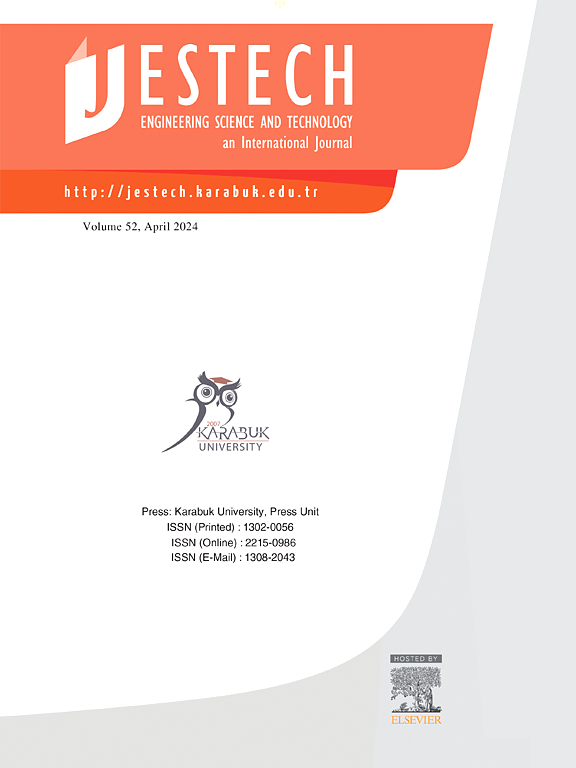Deformation prediction in innovative implant design with machine learning approaches
IF 5.4
2区 工程技术
Q1 ENGINEERING, MULTIDISCIPLINARY
Engineering Science and Technology-An International Journal-Jestech
Pub Date : 2025-07-03
DOI:10.1016/j.jestch.2025.102133
引用次数: 0
Abstract
This study includes experimental research on a classic implant and a sleeved implant, both designed for experimental purposes and produced as samples for testing. The effects of the sleeved implant, an innovative design in dental implantology, on the jawbone were examined through experimental tests, and the data obtained were analyzed using machine learning (ML). Unlike classic implants, the sleeved implant is predicted to provide a more homogeneous distribution of chewing forces on the bone by reducing stress concentrations around the implant. This innovative design aims to strengthen the integration between the jawbone and the implant, increase the implant’s long-term stability, and reduce bone deformation.
In the experimental part of the study, sleeved and classic implants were produced as samples mounted on cow bones. Then, these implants were tested by subjecting them to various pressures and chewing forces using a double-acting pneumatic mechanism. The deformations of the implants on the bone were recorded with digital load cells and measured with relevant measuring devices. 4263 usable experimental data were collected for the classic implant, and 8832 for the sleeved implant. The data obtained were modeled using a finite element analysis system (ANSYS), and instantaneous deformation data were collected during the modeling process. These instantaneous deformation data were included as an additional feature in the ML dataset and used in the analysis processes.
In the study, the Kernel Support Vector Machine (Kernel SVM), Kernel Logistic Regression (Kernel LR), and extreme gradient boosting (XGBoost) classification methods were employed to assess the impact of the implant on the jawbone. In the ML models applied to the experimental data, the deformation levels created by the sleeved and classic implants were classified as slightly, medium, and serious loss classes. Among the evaluated models, the XGBoost model demonstrated outstanding classification performance for both implant types. For the XGBoost model, the training and test accuracies were 100 % for both classic and sleeved implants. The model was also subjected to the robustness test, which confirmed its stability and consistent performance across varying data conditions. Moreover, the Kernel SVM model provided 95 % training accuracy and 95 % test accuracy for the traditional implant and 92 % training accuracy and 95 % test accuracy for the sleeved implant. Finally, the Kernel LR model provided 92 % training accuracy and 93 % test accuracy for the classic implant. For the sleeved implant, a training accuracy of 88 % and a test accuracy of 90 % were achieved. These results show that XGBoost was the best-performing model overall, followed by Kernel SVM, while the Kernel LR model performed slightly lower on the sleeved implant than the classic implant. Additionally, the study evaluated precision, recall, F1-score, and Area Under the Receiver Operating Characteristic Curve (AUROC) metrics. The ROC analyses revealed that XGBoost exhibited the highest classification performance among all models, followed by Kernel SVM, while Kernel LR showed relatively low, yet acceptable, discrimination capability.
According to experimental results, it has been determined that the sleeved implant produces similar effects and results to the classic implant. The findings of the obtained ML models confirm that the sleeved implant creates deformation at a similar level to the classic implant and can be considered a reliable alternative in implantology.
机器学习方法在创新种植体设计中的变形预测
本研究包括经典种植体和套筒种植体的实验研究,这两种种植体都是为实验目的而设计的,也都是作为测试样品制作的。通过实验测试,研究了套筒式种植体对颌骨的影响,套筒式种植体是牙科种植学中的一种创新设计,并使用机器学习(ML)对所获得的数据进行了分析。与传统种植体不同,通过减少种植体周围的应力集中,预计套管种植体可以在骨骼上提供更均匀的咀嚼力分布。这种创新的设计旨在加强颌骨与种植体之间的整合,增加种植体的长期稳定性,减少骨变形。在这项研究的实验部分,有套的和经典的植入物作为样品被安装在牛的骨头上。然后,使用双作用气动机构对这些植入物进行各种压力和咀嚼力的测试。用数字称重传感器记录植入物在骨上的变形,并用相关测量设备进行测量。经典种植体收集了4263个可用实验数据,套筒种植体收集了8832个可用实验数据。利用有限元分析系统ANSYS对得到的数据进行建模,并在建模过程中采集瞬时变形数据。这些瞬时变形数据作为ML数据集的附加特征包含在分析过程中。本研究采用核支持向量机(Kernel Support Vector Machine, SVM)、核逻辑回归(Kernel Logistic Regression, LR)和极端梯度提升(extreme gradient boosting, XGBoost)分类方法评估种植体对颌骨的影响。在应用于实验数据的ML模型中,套筒植入物和经典植入物产生的变形水平被划分为轻微、中度和严重损失级别。在评估的模型中,XGBoost模型对两种种植体类型都表现出出色的分类性能。对于XGBoost模型,无论是经典植入体还是套筒植入体,训练和测试的准确率都是100%。该模型还进行了鲁棒性测试,证实了其在不同数据条件下的稳定性和一致性性能。此外,Kernel SVM模型对传统种植体提供95%的训练准确率和95%的测试准确率,对套筒种植体提供92%的训练准确率和95%的测试准确率。最后,Kernel LR模型为经典种植体提供了92%的训练准确率和93%的测试准确率。对于有套的植入物,训练准确率达到88%,测试准确率达到90%。这些结果表明,XGBoost是总体上表现最好的模型,其次是Kernel SVM,而Kernel LR模型在套筒种植体上的表现略低于经典种植体。此外,研究还评估了准确率、召回率、f1评分和受试者工作特征曲线下面积(AUROC)指标。ROC分析显示,XGBoost在所有模型中表现出最高的分类性能,其次是Kernel SVM,而Kernel LR的分类能力相对较低,但可以接受。实验结果表明,套筒式种植体的效果与经典种植体相似。获得的ML模型的结果证实,套筒种植体产生的变形与经典种植体相似,可以被认为是种植学中可靠的替代方案。
本文章由计算机程序翻译,如有差异,请以英文原文为准。
求助全文
约1分钟内获得全文
求助全文
来源期刊

Engineering Science and Technology-An International Journal-Jestech
Materials Science-Electronic, Optical and Magnetic Materials
CiteScore
11.20
自引率
3.50%
发文量
153
审稿时长
22 days
期刊介绍:
Engineering Science and Technology, an International Journal (JESTECH) (formerly Technology), a peer-reviewed quarterly engineering journal, publishes both theoretical and experimental high quality papers of permanent interest, not previously published in journals, in the field of engineering and applied science which aims to promote the theory and practice of technology and engineering. In addition to peer-reviewed original research papers, the Editorial Board welcomes original research reports, state-of-the-art reviews and communications in the broadly defined field of engineering science and technology.
The scope of JESTECH includes a wide spectrum of subjects including:
-Electrical/Electronics and Computer Engineering (Biomedical Engineering and Instrumentation; Coding, Cryptography, and Information Protection; Communications, Networks, Mobile Computing and Distributed Systems; Compilers and Operating Systems; Computer Architecture, Parallel Processing, and Dependability; Computer Vision and Robotics; Control Theory; Electromagnetic Waves, Microwave Techniques and Antennas; Embedded Systems; Integrated Circuits, VLSI Design, Testing, and CAD; Microelectromechanical Systems; Microelectronics, and Electronic Devices and Circuits; Power, Energy and Energy Conversion Systems; Signal, Image, and Speech Processing)
-Mechanical and Civil Engineering (Automotive Technologies; Biomechanics; Construction Materials; Design and Manufacturing; Dynamics and Control; Energy Generation, Utilization, Conversion, and Storage; Fluid Mechanics and Hydraulics; Heat and Mass Transfer; Micro-Nano Sciences; Renewable and Sustainable Energy Technologies; Robotics and Mechatronics; Solid Mechanics and Structure; Thermal Sciences)
-Metallurgical and Materials Engineering (Advanced Materials Science; Biomaterials; Ceramic and Inorgnanic Materials; Electronic-Magnetic Materials; Energy and Environment; Materials Characterizastion; Metallurgy; Polymers and Nanocomposites)
 求助内容:
求助内容: 应助结果提醒方式:
应助结果提醒方式:


